
Cake flour has a fine texture and low protein content, which enable it to cook in to a crunchy fried crust more effectively than other wheat-based flours. But the flour you use to fry chicken is only a matter of preference -- many alternatives to cake flour are available. Other kitchen staples and various specialty products coat chicken equally well without forsaking the golden, crispy surface that makes fried chicken so delectable. Some alternative ingredients have qualities that may make your fried chicken even better.
The Duplication Formulation
Cake flour contains less gluten than other wheat flours. Flour with a high gluten content yields a tough, chewy fried coating that is prone to absorbing too much oil. Cake flour’s comparatively low protein content yields a lighter, crispier crust. A mixture that contains 7/8 cup of all-purpose flour and 2 tablespoons of cornstarch substitutes for 1 cup of cake flour. Subbing cornstarch, which is gluten-free, for some of the all-purpose flour lowers the overall protein content of the dry mixture. This produces a crunchier crust than all-purpose flour produces on its own. Sift the all-purpose flour and cornstarch together several times to incorporate them thoroughly before you add other ingredients.
Amber Crusts of Grain
Though plain, all-purpose flour produces a chewier crust than cake flour, it is still an acceptable coating for fried chicken. Self-rising flour, which is all-purpose flour combined with baking powder and salt, has benefits that other flours lack. Baking powder increases the pH of the coating, causing it to brown more effectively. The leavening agent also produces tiny gas bubbles while the chicken cooks. The gas bubbles cause the crust to expand and prevent the flour from absorbing excess grease.
Crispy Corn Coatings
Cornstarch produces a supremely crispy crust because it is pure starch without the fiber and protein that flours contain. Due to the absence of protein, cornstarch yields a crumbly, almost sandy, surface. Corn flour -- finely milled cornmeal -- is a staple in many Southern kitchens because it creates an exceptionally crispy, slightly sweet crust on fried foods. Some retail corn flours contain wheat flour to aid in binding, so check the labels on corn flours if you need a gluten-free product. Cornmeal has a grittier texture than flour but still coats chicken effectively. The downside to using cornmeal is that some of it invariably falls off in the oil, and the cornmeal debris burns if you do not skim it out of the pan periodically.
From the Far East
Potato flour and potato starch are common in Asian cuisines, particularly in recipes for chicken karaage, which is Japanese-style fried chicken. A potato-based coating develops a richer golden hue than other fried food coatings. Potato flour causes the chicken to develop a fried potato flavor but potato starch does not. Asian cooks often dredge chicken in rice flour when they prepare stir-fries. Like corn-based coatings, rice flour yields a crispier but more crumbly crust than wheat flours. It also absorbs less oil than its wheat counterparts.
Mix and Match
Many fried chicken recipes call for a blend of flours, matching two ingredients that can offset each other's weaknesses. For example, blending potato starch and self-rising flour delivers the superior browning of potato starch and the light, puffy texture that baking powder creates. But the high protein content of the flour prevents the potato starch from making the crust too crumbly, and the baking powder prevents the wheat flour from absorbing too much oil.
Extra Weight for Extra Crunch
Flour alone creates a thin, crispy crust, but a denser breaded coating has a heartier crunch. Bread, plain potato chips and unsweetened cereal -- particularly light, crisp corn cereals -- make savory, textured crusts for fried chicken. A food processor quickly reduces potato chips, cereal or toasted bread to crumbs that are the perfect consistency for coating chicken. The best breading starts with light layers of flour then egg before applying a layer of dense crumbs.
Related Articles
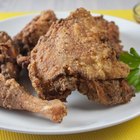
How to Make Good, Crispy Fried Chicken

Can You Use a Baking Mix to Make Fried ...
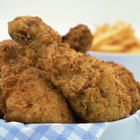
What Can I Substitute for Cake Flour to ...

Whole Wheat Pastry: Flour Substitutions
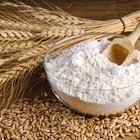
Differences Between Bleached Flour & ...

Bread Flour vs. Cake Flour in Sponge ...

Can You Cook Fried Okra With Flour?

How to Make Blackened Chicken
Frying Shrimp in a Light Batter or Flour

How to Bread Chicken With Flour & Eggs ...
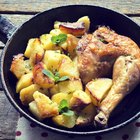
How to Sear and Bake Chicken
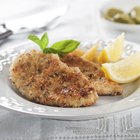
How to Cook Chicken Cutlets Without ...
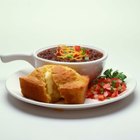
How to Make Cornbread in a Cast-Iron ...

Can You Substitute Whole Wheat Pastry ...
What Is the Difference Between Cake ...
Does Cake Flour Contain Baking Soda & ...
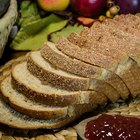
How to Substitute Wheat Germ for Flour

What Is Expeller Pressed Canola Oil?
What Kind of Flour Do You Use for a ...

A Substitute for Eggs in Chicken ...
References
- Joy of Baking: Flour
- Cooking Light: Healthy Frying Basics
- Bon Appetit: Cake Flour
- Serious Eats: The Food Lab: The Best Korean Fried Chicken
- Chicago Tribune: Corn Flour (2) or Cornflour (1): What a Difference a Space Makes
- Los Angeles Times: Back to Basics: Fried Chicken, Made at Home
- Seattle Times: Deep-Fry Success with Japanese-Style Fried Chicken
- Leite’s Culinaria: Chicken Karaage -- Japanese Fried Chicken
- Food & Wine: Oven-Fried Chicken By the Bucket
Writer Bio
Grace Riley has been a writer and photographer since 2005, with work appearing in magazines and newspapers such as the "Arkansas Democrat-Gazette." She has also worked as a school teacher and in public relations and polling analysis for political campaigns. Riley holds Bachelor of Arts degrees in American studies, political science and history, all from the University of Arkansas.
Photo Credits
Jupiterimages/liquidlibrary/Getty Images